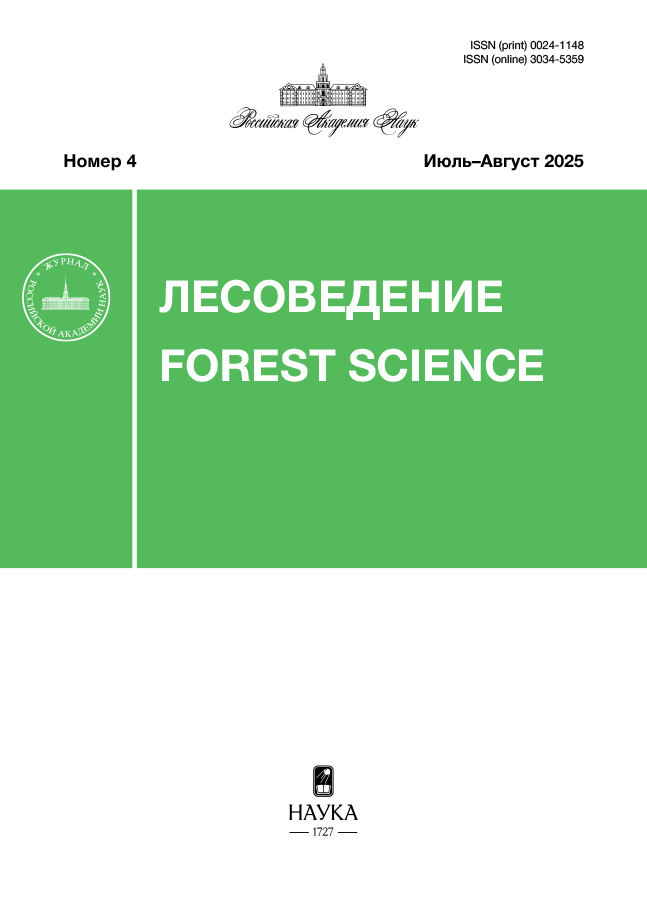Предикторы повреждения насекомыми лесных насаждений по спутниковым данным на примере сибирского шелкопряда
- Авторы: Ковалев А.В.1, Цикалова П.Е.1
-
Учреждения:
- Красноярский научный центр СО РАН
- Выпуск: № 2 (2023)
- Страницы: 150-160
- Раздел: ОРИГИНАЛЬНЫЕ СТАТЬИ
- URL: https://journals.rcsi.science/0024-1148/article/view/137857
- DOI: https://doi.org/10.31857/S002411482302002X
- EDN: https://elibrary.ru/AKBVXY
- ID: 137857
Цитировать
Полный текст
Аннотация
Вспышки массового размножения сибирского шелкопряда (Dendrolimus sibiricus Tschetv.) в таежных лесах Сибири начинаются с очагов площадями в единицы га и достигают площадей в сотни тысяч га, что ведет к значительным повреждениям лесов. Границы очагов изменяются во времени и пространстве в зависимости от внешних факторов, динамики популяции и состояния кормовых деревьев. Борьбу с вредителем необходимо начинать за 1–2 года до достижения пика плотности популяции насекомого. В связи с этим важно знать предикторы повышения численности вредителя, заблаговременно определять момент начала вспышек и зоны, в пределах которых возникают вспышки. Для оценки необходимых условий возникновения вспышки предлагается метод оценки состояния лесных насаждений по данным дистанционного зондирования Земли (ДЗЗ).
Ключевые слова
Об авторах
А. В. Ковалев
Красноярский научный центр СО РАН
Автор, ответственный за переписку.
Email: sunhi.prime@gmail.com
Россия, 660036, Красноярск, Академгородок, д. 50
П. Е. Цикалова
Красноярский научный центр СО РАН
Email: sunhi.prime@gmail.com
Россия, 660036, Красноярск, Академгородок, д. 50
Список литературы
- Болдаруев В.О. Динамика численности сибирского шелкопряда и его паразитов. Улан-Удэ: Бурят. книж. из-во, 1969. 162 с.
- Исаев А.С., Пальникова Е.Н., Суховольский В.Г., Тарасова О.В. Динамика численности лесных насекомых-филлофагов: модели и прогнозы. М.: Товарищество научных изданий КМК, 2015. 276 с.
- Коломиец Н.Г. Паразиты и хищники сибирского шелкопряда. Новосибирск: Наука, 1962. 172 с.
- Кондаков Ю.П. Закономерности массовых размножений сибирского шелкопряда // Экология популяций лесных животных Сибири. Новосибирск: Наука, 1974. С. 206–265.
- Михайлов Ю.З., Сумина Н.Ю. Сибирский шелкопряд Dendrolimus superans (Butler, 1877) и борьба с ним в Иркутской области // Байкальский зоологический журн. 2012. № 3(11). С. 25–29.
- Павлов И.Н., Литовка Ю.А., Голубев Д.В., Астапенко С.А., Хромогин П.В. Новая вспышка массового размножения Dendrolimus sibiricus Tschetv. в Сибири (2012–2017 гг.): закономерности развития и перспективы биологического контроля // Сибирский экологический журн. 2018. № 4. С. 462–478.
- Плешанов А.С. Насекомые – дефолианты лиственничных лесов Восточной Сибири. Новосибирск: Наука, 1982. 209 с.
- Рожков А.С. Массовое размножение сибирского шелкопряда и меры борьбы с ним. М.: Наука, 1965. 178 с.
- Тарасова О.В., Волков В.Е. Влияние погодных условий на развитие вспышек массового размножения сибирского шелкопряда в Средней Сибири // Сибирский лесной журн. 2021. № 5. С. 49–59.
- Эпова В.И., Плешанов А.С. Зоны вредоносности насекомых-филлофагов Азиатской России. Новосибирск: Наука. Сибирская издательская фирма РАН. 1995. 147 с.
- Юрченко Г.И., Турова Г.И. Паразиты сибирского и белополосого шелкопрядов на Дальнем Востоке России // Энтомологические исследования в Сибири. Вып. 2. Красноярск: КФ РЭО. 2002. С. 75–86.
- Bayarjargal Y., Karnieli A., Bayasgalan M., Khudulmur S., Gandush C., Tucker C.J. A comparative study of NOAA-AVHRR derived drought indices using change vector analysis // International J. Remote Sensing. 2006. V. 105. № 1. P. 9–22.
- Bjørnstad O.N., Peltonen M., Liebhold A.M., Baltensweiler W. Waves of larch budmoth outbreaks in the European Alps // Science. 2002. V. 298. № 5595. P. 1020–1023.
- Boyd I.L., Freer-Smith P.H., Gilligan C.A., Godfray H.C.J. The consequence of tree pests and diseases for ecosystem services // Science. 2013. V. 342. P. 823.
- Cunha M., Richter C. A time-frequency analysis on the impact of climate variability with focus on semi-natural montane grassland meadows // IEEE Trans. Geosci. Remote Sens. 2014. V. 52. № 10. P. 6156–6164.
- Fahse L., Heurich M. Simulation and analysis of outbreaks of bark beetle infestations and their management at the stand level // Ecological Modelling. 2011. V. 222. № 11. P. 1833–1846.
- Fernández A., Fort H. Catastrophic phase transitions and early warnings in a spatial ecological model // J. Statistical Mechanics: Theory and Experiment. 2009. V. 9. P. P09014.
- Ims R.A., Yoccoz N.G., Hagen S.B. Do sub-Arctic winter moth populations in coastal birch forest exhibit spatially synchronous dynamics? // J. Animal Ecology. 2004. V. 73. P. 1129–1136.
- Johnson D.M., Liebhold A.M., Tobin P.C. Bjørnstad O.N. Allee effects and pulsed invasion by the gypsy moth // Nature. 2006. V. 444. P. 361–363.
- Kautz M., Meddens A.J.H., Hall R.J. Arneth A. Biotic disturbances in northern hemisphere forests-a synthesis of recent data, uncertainties and implications for forest monitoring and modeling // Global Ecology and Biogeography. 2017. V. 26. № 5. P. 533–552.
- Kosiba A.M., Meigs G.W., Tait E.R. Spatiotemporal patterns of forest damage and disturbance in the northeastern United States: 2000–2016 // Forest Ecology and Management. 2018. V. 430. P. 94–104.
- Kovalev A., Soukhovolsky V. Analysis of Forest Stand Resistance to Insect Attack According to Remote Sensing Data // Forests. 2021. V. 12. P. 1188. https://doi.org/10.3390/f12091188
- Lewis M.A., Nelson W., Xu. C. A structured threshold model for mountain pine beetle outbreak // Bulletin of Mathematical Biology. 2010. V. 72. P. 565–589.
- Liang L., Chen Y., Hawbaker T., Zhu Z., Gong P. Mapping mountain pine beetle mortality through growth trend analysis of time-series landsat data // Remote Sens. 2014. V. 6. P. 5696–5716.
- Liebhold A.M., Koenig W.D., Bjørnstad O.N. Spatial synchrony in population dynamics // Annual Review of Ecology, Evolution, and Systematics. 2004. V. 35. P. 467–490.
- Liu Yan, Hill M.J., Zhang Xiaoyang, Wang Zhuosen, Richardson A.D., Hufkens K., Filippa G., Baldocchi D.D., Ma Siyan, Verfaillie J., Schaaf C.B. Using data from Landsat, MODIS, VIIRS and Pheno Cams to monitor the phenology of California oak/grass savanna and open grassland across spatial scales // Agricultural and Forest Meteorology. 2017. V. 237–238. P. 311–325.
- Logan J.A., White P., Bentz B.J., Powell J.A. Model analysis of spatial patterns in mountain pine beetle outbreaks // Theoretical Population Biology. 1998. V. 53. № 3. P. 236–255.
- Nelson W.A., Bjørnstad O.N., Yamanaka T. Recurrent insect outbreaks caused by temperature-driven changes in system stability // Science. 2013. V. 341. № 6147. P. 796–799.
- Olsson P.O., Lindstrom J., Eldundh L. Near real-time monitoring of insect induced defoliation in subalpine birch forests with MODIS derived NDVI // Remote Sensing of Environment. 2016. V. 181. P. 42–53.
- Peters D.P.C., Pielke R.A., Bestelmeyer B.T., Allen C.D., Munsonmcgee S., Havstad K.M. Cross-scale interactions, nonlinearities, and forecasting catastrophic events // Proceedings of the National Academy of Sciences. 2004. V. 101. P. 15130–15135.
- Raffa K.F., Aukema B.H., Bentz B.J., Carroll A.L., Hicke J.A., Turner M.G., Romme W.H. Cross-scale drivers of natural disturbances prone to anthropogenic amplification: the dynamics of bark beetle eruptions // Bioscience. 2008. V. 58. № 6. P. 501–517.
- Rechid D., Raddatz T.J., Jacob D. Parameterization of snow-free land surfacealbedo as a function of vegetation phenology based on MODIS data and appliedin climate modelling // Theoretical and Applied Climatology. 2009. V. 95. P. 245–255.
- Royama T. Population dynamics of the spruce budworm Choristoneura fumiferana // Ecological Monographs. 1984. V. 54. № 4. P. 429–462.
- Seidl R., Müller J., Hothorn T., Bässler C., Heurich M., Kautz M. Small beetle, large-scale drivers: how regional and landscape factors affect outbreaks of the european spruce bark beetle // J. Applied Ecology. 2016. V. 53. № 2. P. 530–540.
- Seidl R., Thom D., Kautz M., Martin-Benito D., Peltoniemi M., Vacchiano G., Wild J., Ascoli D., Petr M., Honkaniemi J. Forest disturbances under climate change // Nature Climate Change. 2017. V. 7. № 6. P. 395.
- Senf C., Campbell E.M., Pflugmacher D., Wulder M.A., Hostert P. A multi-scale analysis of western spruce budworm outbreak dynamics // Landscape Ecology. 2017. P. 1–14.
- Spruce J.P., Sader S., Ryan R.E., Smoot J., Kuper P., Ross K., Prados D., Russell J., Gasser G., McKellip R., Hargrove W. Assessment of MODIS NDVI time series data products for detecting forest defoliation by gypsy moth outbreaks // Remote Sensing of Environment. 2011. V. 115. P. 427–437.
- Tenow O., Nilssen A.C., Bylund H. Geometrid outbreak waves travel across Europe // J. Animal Ecology. 2012. V. 82. № 1. P. 84–95.
- Thayn J.B. Using a remotely sensed optimized Disturbance Index to detect insect defoliation in the Apostle Islands, Wisconsin, USA // Remote Sensing of Environment. 2013. V. 136. P. 210–217.
- Tucker C.J., Sellers P.J. Satellite remote sensing of primary production // J. Remote Sensing. 1986. V. 7. P. 1395–1416.
- Verbesselt J., Zeileis A., Herold M. Near real-time disturbance detection using satellite image time series // Remote Sensing of Environment. 2012. V. 123. P. 98–108.
- Williams D.W., Liebhold A.M. Spatial synchrony of spruce budworm outbreaks in eastern North America // Ecology. 2000. V. 81. P. 2753–2766.
- Zhou G., Liebhold A.M. Forecasting the spatial dynamics of gypsy moth outbreaks using cellular transition models // Landscape Ecology. 1995. V.10. № 3. P. 177–189.
Дополнительные файлы

















